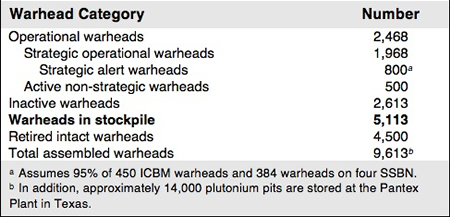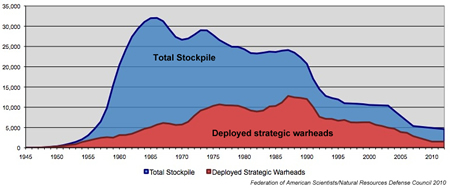United States Discloses Size of Nuclear Weapons Stockpile
 |
| The Obama administration has declassified the history and size of the U.S. nuclear weapons stockpile, a long-held national secret. Click image to get the fact sheet. |
By Hans M. Kristensen
The Obama administration has formally disclosed the size of the Defense Department’s stockpile of nuclear weapons: 5,113 warheads as of September 30, 2009.
For a national secret, we’re pleased that the stockpile number is only 87 warheads off the estimate we made in February 2009. By now, the stockpile is probably down to just above 5,000 warheads.
The disclosure is a monumental step toward greater nuclear transparency that breaks with outdated Cold War nuclear secrecy and will put significant pressure on other nuclear weapon states to reciprocate.
The stockpile disclosure, along with the rapid reduction of operational deployed warheads disclosed yesterday, the Obama administration is significantly strengthening the U.S. position at the Nuclear Non-Proliferation Treaty (NPT) Review Conference.
Progress toward deep nuclear cuts and eventual nuclear disarmament would have been very difficult without disclosing the inventory of nuclear weapons.
FAS and others have long advocated disclosure and argued that keeping the size of the nuclear arsenal secret serves no real national security purpose in the post-Cold War era. Now that the size of the nuclear stockpile is no longer a secret, that dismantlement numbers are no longer secret, and the number of deployed strategic warheads is no longer a secret, the United States should also disclose the total number of strategic and non-strategic weapons in the stockpile.
Stockpile History and Forecast
When the Bush administration took office in 2001, the stockpile included 10,526 warheads. In June 2004, the NNSA announced a decision to cut the 2001 stockpile “nearly in half” by 2012. That goal was achieved five years early in December 2007, at which point the White House announced an additional cut of 15 percent by 2012. Once these reductions are completed, the stockpile will include approximately 4,600 warheads, a force level last seen in 1956.
.
The Obama administration has not yet announced a decision to further reduce the nuclear stockpile, but there are several hints in the Nuclear Posture Review (NPR) that it intends to reduce the stockpile further. The NPR states that the United States will be “significantly reducing the size of the technical hedge overall,” a reference to the thousands of non-deployed but intact warheads kept in storage for potential upload back unto missiles and bombers in case of Russia or China building up and to replace warheads that develop technical problems.
The NPR also states that the number of warheads awaiting dismantlement “will increase as weapons are removed from the stockpile under New START.” Since the New START does not require removing weapons from the stockpile – only from strategic delivery vehicles – this is also a reference to further stockpile reductions. One senior official told me that some of these reductions would be made soon.
But the “major reductions in the nuclear stockpile” promised by the NPR appear to be conditioned on “implementation of the Stockpile Stewardship Program and the nuclear infrastructure investments….” If Congress approves these investments, some “hedge” warheads can “be retired along with other stockpile reductions planned over the next decade.”
| Estimated U.S. Nuclear Weapons Inventories, 2010 |
 |
| The nuclear stockpile is only a portion of the total U.S. inventory of nuclear weapons. We estimate the total number of assembled warheads is close to 9,600, probably a little less given ongoing dismantlement of retired warheads. |
.
Stockpile Warhead Categories
The stockpile contains many subcategories of warheads. There are two overall categories: active and inactive. The active category includes two subcategories: deployed warheads on missiles and bomber bases and nondeployed warheads in the “Responsive Force” for uploading in case of Russia or China building up or technical failure of deployed warheads. The inactive category includes warheads without limited-life components (such as tritium) in long-term storage.
But since the stockpile is always in a flux with warheads being moved between platforms and maintenance, each of these subcategories have numerous other categories that relate to the readiness of the warheads. According to information obtained from the government, there are four readiness state (RS) categories related to warhead functions:
RS-A: Warheads that may be used for possible wartime employment.
RS-B: Warheads intended to be used for logistical purposes (e.g., LLC exchange (LLCE), repairs, surveillance, transportation, etc.).
RS-C: Warheads intended to be used for QUART replacement.
RS-D: Warheads intended to be used for reliability replacement.
There are also five readiness state categories that relate to the warhead location an maintenance requirements:
RS-1: Active stockpile warheads intended to be located primarily on launchers or at an operational base.
RS-2: Active stockpile warheads intended to be located primarily at either an operational base or depot.
RS-3: Inactive stockpile warheads intended to be located primarily at a depot, have the LLCs removed as soon as logistically practical, require refurbishment, and require reliability and safety assessments.
RS-4: Inactive stockpile warheads intended to be located primarily at a depot, have the LLCs removed as soon as logistically practical, do NOT require refurbishment, but do require reliability and safety assessments.
RS-5: Inactive stockpile warheads intended to be located at a depot, have LCCs removed as soon as logistically practical, do NOT require refurbishment, do NOT require reliability assessments, but do require safety assessments.
Other Countries
The disclosure puts pressure of the other nuclear weapon states to reciprocate. Nuclear weapon states that do not disclose the size of their nuclear arsenals will now be seen as secretive and obstructing nuclear transparency and progress towards deep cuts and eventually disarmament. Some nuclear countries have given ballpark numbers:
The Chinese Foreign Ministry declared in a fact sheet in 2004 that, “Among the nuclear-weapon states, China. . . possesses the smallest nuclear arsenal.” That suggested fewer than 200 operationally available warheads, as declared by Britain in 1998. (See also the latest Nuclear Notebook on China.)
Britain further declared in 2007 that it would “reduce the maximum number of operationally available warheads from fewer than 200 to fewer than 160” by 2007. This suggests that a limited inventory of non-operationally available warheads exists.
France declared in 2008 that its “arsenal will include fewer than 300 nuclear warheads” following a reduction of the bombers. French president Nicolas Sarkozy claimed France was “completely transparent because it has no other weapons beside those in its operational arsenal.” Nonetheless, a small number of spares or warheads undergoing surveillance probably exist in additional to those in the “operational arsenal.” (See also the latest Nuclear Notebook on France.)
Russia has not, to my knowledge, disclosed anything about the size of its stockpile. (See latest Nuclear Notebook on Russia.)
Dismantlements
The Pentagon also released warhead dismantlement numbers back to 1995. I’ll blog later on what that means.
This publication was made possible by a grant from Carnegie Corporation of New York and Ploughshares Fund. The statements made and views expressed are solely the responsibility of the author.
The FY2026 National Defense Authorization Act (NDAA) paints a picture of a Congress that is working to both protect and accelerate nuclear modernization programs while simultaneously lacking trust in the Pentagon and the Department of Energy to execute them.
While advanced Chinese language proficiency and cultural familiarity remain irreplaceable skills, they are neither necessary nor sufficient for successful open-source analysis on China’s nuclear forces.
Satellite imagery has long served as a tool for observing on-the-ground activity worldwide, and offers especially valuable insights into the operation, development, and physical features related to nuclear technology.
This report outlines a framework relying on “Cooperative Technical Means” for effective arms control verification based on remote sensing, avoiding on-site inspections but maintaining a level of transparency that allows for immediate detection of changes in nuclear posture or a significant build-up above agreed limits.
